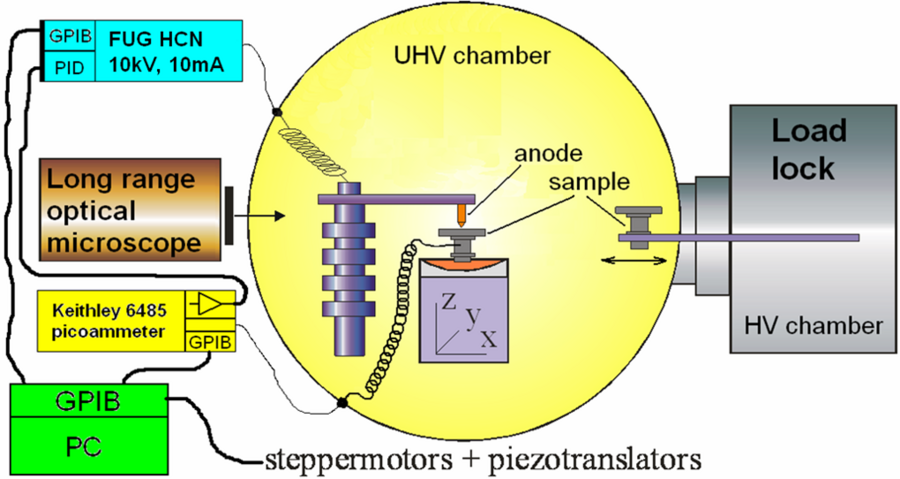Feldemissionsrastermikroskop (FERM):

The FESM (see Figure) is an advanced microscope for investigation of FE site distributions on “flat” cathodes of up to 25 x 25 mm2. The cathode is xy-surface tilt-corrected with respect to the anode to achieve a constant gap Δz within ±5 µm for the full scan area. The measurements are done in ultrahigh vacuum (UHV) of 10-9 mbar by means of non-destructive regulated voltage scans V(x, y) at a fixed FE current (from 1 nA to 10 mA). It employs a PID- regulated power supply FUG HCN100M-10000 [Fug] controlled by the FE current measured by a digital picoammeter Keithley 6485 or an analog electrometer Keithley 610C [Key] as described elsewhere [Lys05, Lys06]. The power supply provides up to 10 mA current and 10 kV voltage, which corresponds to 500 MV/m macroscopic field at 20 µm gap.
By in-situ exchange between needle-anodes and flattened conical anodes, the alignment, homogeneity, and efficiency of FE from selected cathode areas can be verified with the required resolution, and the integral current of arbitrarily chosen individual emitters or patches can be measured. The needle anodes have a tip apex radius from Ra ≥ 1 µm, while the flattened conical anodes are up to 300 µm diameter. The anodes are mechanically prepared and finally smoothed or, in case of the needle-anodes, sharpened by means of electrochemical etching in 10% water solution of NaOH and consist of tungsten-tantalum alloy 90:10. The local FE measurements give values of the onset field Eon, an effective field enhancement factor βeff and the maximum current capability Imax. The macroscopic electric field E is calibrated for each emitter as the linear slope of the PID-regulated V(z) dependence for 1 nA current. Moreover, the real distance d between the tip anode and the relevant emitter is determined by the linear extrapolation of each V(z) curve to zero voltage [Nav09a].
Exemplaric measurement results:
